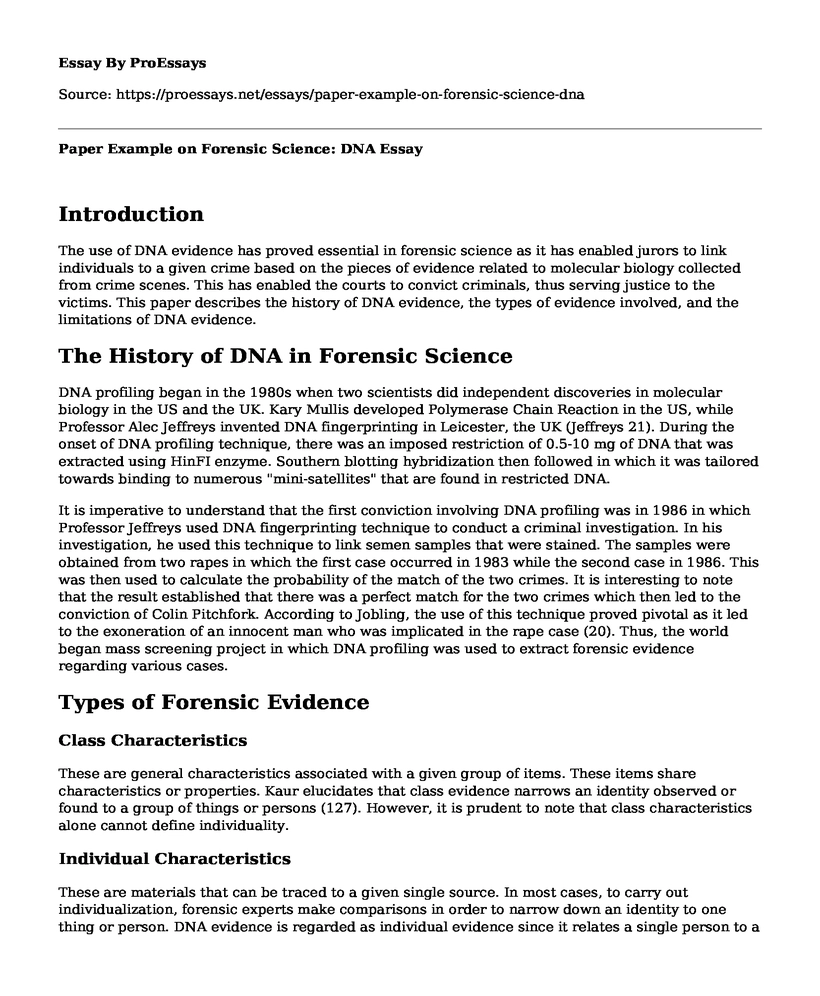Introduction
The use of DNA evidence has proved essential in forensic science as it has enabled jurors to link individuals to a given crime based on the pieces of evidence related to molecular biology collected from crime scenes. This has enabled the courts to convict criminals, thus serving justice to the victims. This paper describes the history of DNA evidence, the types of evidence involved, and the limitations of DNA evidence.
The History of DNA in Forensic Science
DNA profiling began in the 1980s when two scientists did independent discoveries in molecular biology in the US and the UK. Kary Mullis developed Polymerase Chain Reaction in the US, while Professor Alec Jeffreys invented DNA fingerprinting in Leicester, the UK (Jeffreys 21). During the onset of DNA profiling technique, there was an imposed restriction of 0.5-10 mg of DNA that was extracted using HinFI enzyme. Southern blotting hybridization then followed in which it was tailored towards binding to numerous "mini-satellites" that are found in restricted DNA.
It is imperative to understand that the first conviction involving DNA profiling was in 1986 in which Professor Jeffreys used DNA fingerprinting technique to conduct a criminal investigation. In his investigation, he used this technique to link semen samples that were stained. The samples were obtained from two rapes in which the first case occurred in 1983 while the second case in 1986. This was then used to calculate the probability of the match of the two crimes. It is interesting to note that the result established that there was a perfect match for the two crimes which then led to the conviction of Colin Pitchfork. According to Jobling, the use of this technique proved pivotal as it led to the exoneration of an innocent man who was implicated in the rape case (20). Thus, the world began mass screening project in which DNA profiling was used to extract forensic evidence regarding various cases.
Types of Forensic Evidence
Class Characteristics
These are general characteristics associated with a given group of items. These items share characteristics or properties. Kaur elucidates that class evidence narrows an identity observed or found to a group of things or persons (127). However, it is prudent to note that class characteristics alone cannot define individuality.
Individual Characteristics
These are materials that can be traced to a given single source. In most cases, to carry out individualization, forensic experts make comparisons in order to narrow down an identity to one thing or person. DNA evidence is regarded as individual evidence since it relates a single person to a crime committed (Devine & Caughlin 109).
The Limitations of DNA as Forensic Evidence
Even though DNA evidence has gained prominence as a pivotal tool in solving cases, using this evidence has underlying limitations. For instance, DNA evidence is prone to human error during testing in the laboratory. In addition, most criminals do not leave DNA evidence in crime scenes, and therefore relying on this technique as a sole tool for providing evidence in courts is inadequate. It is also worthy to note that many jurors have unrealistic expectations about DNA forensic evidence. As a result, justice may not be served to the victim as evidence may be uncertain and flawed. According to Maeder and Corbett, this phenomenon is referred to as "The CSI effect" which describes the influence that watching the television show dubbed "Crime Scene Investigation" has on the behavior of juror (pp.83-114).
Conclusion
DNA evidence has been a major breakthrough in forensic science. It has enabled exoneration of the innocent while at the same time convicted the guilty. However, DNA evidence should not be used exclusively as forensic evidence since it has limitations that make it inefficient. Other evidence such as testimonies, physical evidence, and confessions should be used.
Works Cited
Devine, Dennis J., and David E. Caughlin. "Do they matter? A meta-analytic investigation of individual characteristics and guilt judgments." Psychology, Public Policy, and Law 20.2 (2014): 109.
Jeffreys, Alec J. "The man behind the DNA fingerprints: an interview with Professor Sir Alec Jeffreys." Investigative Genetics 4.1 (2013): 21.
Jobling, Mark A. "Curiosity in the genes: the DNA fingerprinting story." Investigative Genetics 4.1 (2013): 20.
Kaur, Sandeep, et al. "Analysis and identification of bite marks in forensic casework." Oral Health Dent Manag 12.3 (2013): 127-31.
Maeder, Evelyn M., and Richard Corbett. "Beyond frequency: Perceived realism and the CSI effect." Canadian Journal of Criminology and Criminal Justice 57.1 (2015): 83-114.
Steele, Christopher D., and David J. Balding. "Statistical evaluation of forensic DNA profile evidence." Annual Review of Statistics and Its Application 1 (2014): 361-384.
Cite this page
Paper Example on Forensic Science: DNA. (2022, Jun 02). Retrieved from https://proessays.net/essays/paper-example-on-forensic-science-dna
If you are the original author of this essay and no longer wish to have it published on the ProEssays website, please click below to request its removal:
- Criminal Behavior and Mental Health
- Research Paper on Fraud
- Reflection Paper Over New Jack by Ted Conover
- Essay Sample on Andrea Yates: Life Sentenced for Unthinkable Act
- Human Freedom: Enhancing and Limiting Factors - Essay Sample
- Trademark & Servicemark: Court Ruling on Case Involving Trademark - Essay Sample
- Martin Luther King Jr.'s Letter From Birmingham Jail - Free Essay Sample







